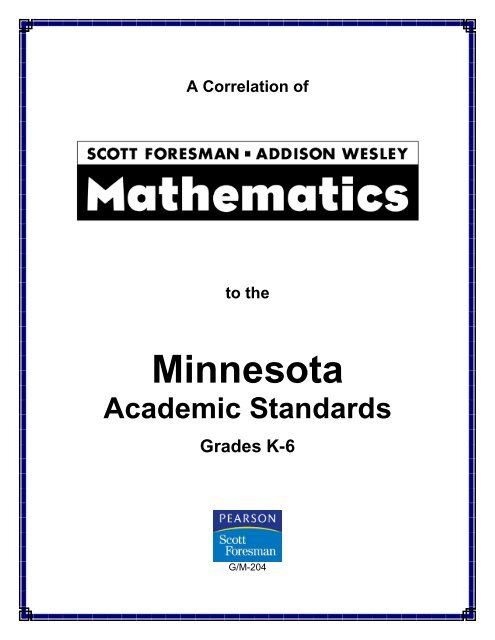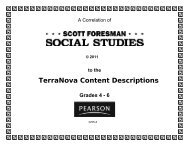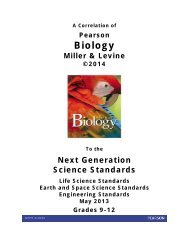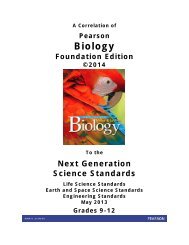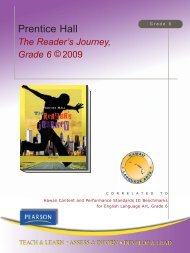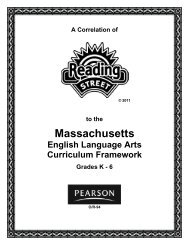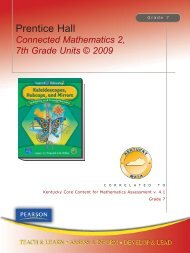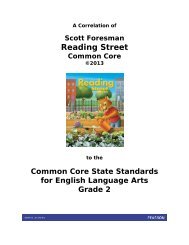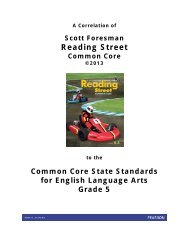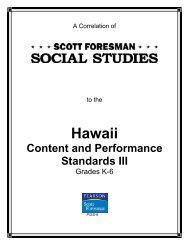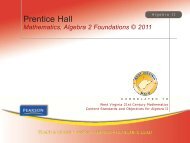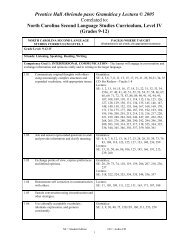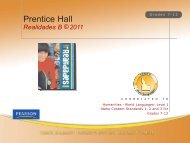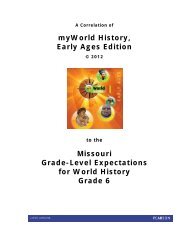Scott Foresman â Addison Wesley Mathematics
Scott Foresman â Addison Wesley Mathematics
Scott Foresman â Addison Wesley Mathematics
You also want an ePaper? Increase the reach of your titles
YUMPU automatically turns print PDFs into web optimized ePapers that Google loves.
A Correlation ofto theMinnesotaAcademic StandardsGrades K-6G/M-204
IntroductionThis document demonstrates the high degree of success students will achieve when using<strong>Scott</strong> <strong>Foresman</strong> – <strong>Addison</strong> <strong>Wesley</strong> <strong>Mathematics</strong> in meeting the objectives of the MinnesotaAcademic Standards. Correlation page references are to the Teacher Edition, which containsfacsimile Pupil Edition pages.<strong>Scott</strong> <strong>Foresman</strong> – <strong>Addison</strong> <strong>Wesley</strong> <strong>Mathematics</strong> was carefully developed to reflect thespecific needs of students and teachers at every grade level, while maintaining an overallprimary goal: to have math make sense from every perspective. This program is based onscientific research that describes how children learn mathematics well and on classroom-basedevidence that validates proven reliability.• Reaching All Learners<strong>Scott</strong> <strong>Foresman</strong> – <strong>Addison</strong> <strong>Wesley</strong> <strong>Mathematics</strong> addresses the needs of every studentthrough structured instruction that makes concepts easier for students to grasp. Lessonsprovide step-by-step examples that show students how to think about and solve the problem.Built-in leveled practice in every lesson allows the teacher to customize instruction to matchstudents’ abilities. Reaching All Learners, featured in the Teacher Edition, helps teachers meetthe diverse needs of the classroom with fun and stimulating activities that are easy toincorporate directly into the lesson plan.• Test Prep<strong>Scott</strong> <strong>Foresman</strong> - <strong>Addison</strong> <strong>Wesley</strong> <strong>Mathematics</strong> builds understanding through connections toprior knowledge, math strands, other subjects and the real world. It provides practice formaximum results and offers assessment in a variety of ways. Besides carefully placed reviewsat the end of each Section, an important Test Prep strand runs throughout the program. Writingexercises prepare students for open-ended and short-or extended-response questions on stateand national tests. Spiral review in a test format help students keep their test-taking skills sharp.• Priority on problem solving:Problem-solving instruction is systematic and explicit. Reading connections help children withproblem-solving skills and strategies for math. Reading for Math Success encourages studentsto use the reading skills and strategies they already know to solve math problems.• Instructional SupportIn the Teacher Edition, the Lesson Planner provides an easy, at-a-glance planning tool. Itidentifies objectives, math understandings, focus questions, vocabulary, and resources for eachlesson in the chapter. Professional Development at the beginning of each chapter in theTeacher Edition includes a Skills Trace as well as Math Background and Teaching Tips for eachsection in the chapter.Ancillaries help to reach all learners with practice, problem solving, hands-on math, languagesupport, assessment and teacher support. Technology resources for both the student and theteacher provide a whole new dimension to math instruction by helping to create motivating andengaging lessons.
Table of ContentsKindergarten………………………………...…………………………………….….……..…1Grade One……………………………………………………………………….…….……..…6Grade Two………………………………………………………………..……………....……11Grade Three…………………………………………………………………..…………...…..18Grade Four……………………………………………………………………………...….....25Grade Five……………………………………………………………………………….….....32Grade Six ……………………………………………………………………………….…..…39
<strong>Scott</strong> <strong>Foresman</strong> – <strong>Addison</strong> <strong>Wesley</strong> <strong>Mathematics</strong>to theMinnesota Academic StandardsKindergartenThese standards and benchmarks are to be used as a source document for identifyingwhat all students should know and be able to do to demonstrate mathematicalproficiency. To determine grade level placement of specific standards and benchmarks,judgment by experienced teachers was used to determine at what grade level 80% ofchildren would master the specific material.The current document identifies the grade at which mastery of each concept is expectedbut does not identify when those concepts are introduced and reinforced. Schools mustdetermine where in their curriculum these concepts would be introduced and reinforcedso that they may be assessed at the indicated grade level.Teachers must develop and enrich students’ knowledge of mathematics beyond what isoutlined in this document. It is critical for teachers to recognize the entire progression ofstandards and benchmarks before and after their grade level.The grade level designations in the K-2 Minnesota Academic Standards arestrongly recommended. However, school districts may place the K-2 standards atgrade levels that accommodate their particular curriculum, provided that allstandards have been mastered by the end of grade 2.I. MATHEMATICAL REASONINGStandard: Apply skills of mathematical representation, communication and reasoningthroughout the remaining four content strands.Reasoning lies at the heart of mathematical proficiency. As such, it is an essentialstrand of mathematics. The Mathematical Reasoning standards will primarily beassessed within the context of the standards in the remaining four content strands. Thedepth of mathematical reasoning will increase as the skill level in the four other strandsincreases.The student will:1. Create and solve word problems using actions, objects, words, pictures, ornumbers.67A-67B, 67, 68, 125-126, 185-186, 217A-217B, 217, 218______________________________________________________________________Kindergarten 1
<strong>Scott</strong> <strong>Foresman</strong> – <strong>Addison</strong> <strong>Wesley</strong> <strong>Mathematics</strong>Minnesota Academic Standards2. Estimate and check that answers are reasonable.119-120, 127-128, 141A-141B, 141-142, 147A-147B, 147-148, 151A-151B, 151-1523. Explain to others how a problem was solved.47-48, 21-22, 71A-71B, 71-72, 97-98, 127A-127B, 127-128, 155A-155B, 155-156,239A-239B, 239-240, 299-300II. NUMBER SENSE, COMPUTATION, AND OPERATIONSA. Number SenseStandard: Represent quantities using whole numbers and understand relationshipsamong whole numbers.The student will:1. Count forward to 31, backward from 10.115A-115B, 115-1162. Count the number of objects in a set and identify the quantity.291A, 291B, 291-2923. Compare the number of objects in two or more sets.27A, 29A4. Given a number, identify one more or one less.235A-235B, 235-236, 237A-237B, 237-238B. Computation and OperationStandard: Add and subtract whole numbers up to 6 in real-world and mathematicalproblems.The student will:1. Recognize the number of objects up to 6, without counting.Related Content: 53A, 53B, 53-54, 55A, 55B, 55-56, 57A-57B, 57-58, 59A-59B, 59-60______________________________________________________________________Kindergarten 2
<strong>Scott</strong> <strong>Foresman</strong> – <strong>Addison</strong> <strong>Wesley</strong> <strong>Mathematics</strong>Minnesota Academic Standards2. Add and subtract whole numbers up to 6, using concrete objects.227A-227B, 227-228III. PATTERNS, FUNCTIONS AND ALGEBRAA. Patterns and FunctionsStandard: Sort, classify and compare objects based on their attributes. Understandsimple repeating patterns.The student will:1. Sort objects in a set by one attribute such as size, shape, color or thickness.37A-37B, 37-38, 39A-39B, 39-40, 217A-217B, 217-2182. Identify an object that does not belong in a set.13A, 13B, 13-14, 15A, 15B, 15-16, 17A, 17B, 17-183. Recognize, describe and extend repeating patterns involving up to threeelements using objects, pictures, sounds or movements.35A-35B, 35-36, 43A-43B, 43-44, 95A-95B, 95-96, 217A-217B, 217-218, 297-298B. Algebra (Algebraic Thinking)(Standards under this heading may be locally determined.)35A-35B, 35-36, 37A-37B, 37-38, 39A-39B, 39-40, 41A-41B, 41-42, 43A-43B, 43-44,45A-45B, 45-46, 63A-63B, 63-64, 65A-65B, 65-66, 87A-87B, 87-88, 91A-91B, 91-92,95A-95B, 95-96, 113A-113B, 113-114, 121A-121B, 121-122, 255A-255B, 255-256,275A-275B, 275-276, 293A-293B, 293-294, 295A-295B, 295-296, 297A-297B, 297-298______________________________________________________________________Kindergarten 3
<strong>Scott</strong> <strong>Foresman</strong> – <strong>Addison</strong> <strong>Wesley</strong> <strong>Mathematics</strong>Minnesota Academic StandardsIV. DATA ANALYSIS, STATISTICS AND PROBABILITYA. Data and StatisticsStandard: Depict data with objects and pictures.The student will:1. Represent data about classmates or their surroundings by using objects orpictures.29A-29B, 29-30, 31, 31A-31B, 32, 33A-33B, 33-34B. Probability (Standards under this heading may be locally determined.)Students are introduced to this concept in Grade 1.V. SPATIAL SENSE, GEOMETRY, AND MEASUREMENTA. Spatial SenseStandard: Understand meaning of terms used to describe location and placement ofobjects.The student will:1. Locate and describe placement of objects with terms such as: on, inside,outside, above, below, over, under, beside, between, in front of, behind, next to,top, bottom.3A-3B, 3-4, 5A-5B, 5-6, 7A-7B, 7-8B. GeometryStandard: Sort two- and three-dimensional shapes.The student will:1. Sort two- and three-dimensional shapes according to their geometricalattributes.209A-209B, 209-210, 219-220______________________________________________________________________Kindergarten 4
<strong>Scott</strong> <strong>Foresman</strong> – <strong>Addison</strong> <strong>Wesley</strong> <strong>Mathematics</strong>Minnesota Academic StandardsC. MeasurementStandard: Understand terms and comparative language used in various measurementsituations. Identify tools to measure time. Identify coins.The student will:1. Compare and order objects by length, weight, volume, temperature or size anduse appropriate vocabulary such as longer than, holds more, smaller.139A-139B, 139-140, 141A-141B, 141-142, 147A-147B, 147-148, 151A-151B, 151-152,153A-153B, 153-1542. Know that clocks and calendars are instruments to measure time.173A, 173B, 173-174, 175A, 175B, 175-1763. Recognize the following coins: penny, nickel, dime and quarter.179A-179B, 179-180, 181A-181B, 181-182, 183A-183B, 183-184, 187A-187B, 187-1884. Compare and order events based on time and use appropriate vocabulary suchas yesterday, today or tomorrow to describe relative time.159, 169-170______________________________________________________________________Kindergarten 5
<strong>Scott</strong> <strong>Foresman</strong> – <strong>Addison</strong> <strong>Wesley</strong> <strong>Mathematics</strong>to theMinnesota Academic StandardsGRADE 1These standards and benchmarks are to be used as a source document for identifyingwhat all students should know and be able to do to demonstrate mathematicalproficiency. To determine grade level placement of specific standards and benchmarks,judgment by experienced teachers was used to determine at what grade level 80% ofchildren would master the specific material.The current document identifies the grade at which mastery of each concept is expectedbut does not identify when those concepts are introduced and reinforced. Schools mustdetermine where in their curriculum these concepts would be introduced and reinforcedso that they may be assessed at the indicated grade level.Teachers must develop and enrich students’ knowledge of mathematics beyond what isoutlined in this document. It is critical for teachers to recognize the entire progression ofstandards and benchmarks before and after their grade level.The grade level designations in the K-2 Minnesota Academic Standards arestrongly recommended. However, school districts may place the K-2 standards atgrade levels that accommodate their particular curriculum, provided that allstandards have been mastered by the end of grade 2.I. MATHEMATICAL REASONINGStandard: Apply skills of mathematical representation, communication and reasoningthroughout the remaining four content strands.Note about assessment of this standard: The Mathematical Reasoning standardswill primarily be assessed within the context of the standards in the remainingfour content strands. The depth of mathematical reasoning will increase as theskill level in the four other strands increases.The student will:1. Create and solve word problems using actions, objects, words, pictures ornumbers.7A, 7B, 7-8, 9, 10, 11A, 11B, 21A, 21B, 21-22, 77A, 77B, 78, 79A, 79B, 80, 81, 83, 85,91A, 91B, 91-92, 93A, 93B, 94, 111A, 111B, 111-112, 133A, 133B, 136, 215A, 215B,215-216, 229B, 229, 230, 287A, 287B, 289-290, 291A, 291B, 291-292, 293, 319A,319B, 326, 327, 339A, 339B, 342______________________________________________________________________Grade One 6
<strong>Scott</strong> <strong>Foresman</strong> – <strong>Addison</strong> <strong>Wesley</strong> <strong>Mathematics</strong>Minnesota Academic Standards2. Estimate and check that answers are reasonable.18, 62, 79A, 84, 86, 113A, 113B, 119, 167A, 168, 173A, 175-176, 205A, 206, 211A,213-214, 221A, 221B, 221-222, 223A, 224, 229A, 238, 281A, 281-282, 291A, 291,299A, 299-300, 347A, 349-350, 359, 363, 427A, 427-428, 431A, 431, 442, 443A, 444,453, 467A, 467B, 467-468, 469, 473A, 474, 483A, 4923. Explain to others how a problem was solved.7A, 7B, 7-8, 9, 10, 11A, 11B, 21A, 21B, 21-22, 77A, 77B, 78, 79A, 79B, 80, 81, 83, 85,91A, 91B, 91-92, 93A, 93B, 94, 111A, 111B, 111-112, 133A, 133B, 136, 215A, 215B,215-216, 229B, 229, 230, 287A, 287B, 289-290, 291A, 291B, 291-292, 293, 319A,319B, 326, 327, 339A, 339B, 342II. NUMBER SENSE, COMPUTATION AND OPERATIONSA. Number SenseStandard: Understand place value, ways of representing whole numbers andrelationships among whole numbers. Understand the concept of one half.The student will:1. Read, write numerals for, compare and order numbers to 120.33A, 40, 241B, 241-242, 243A, 243B, 243-244, 303A, 303B, 305, 319A, 319B, 323, 3282. Count by 2s to 30 and by 5s to 120.255A, 255B, 255-256, 257A, 257B, 257-258, 259, 269A, 269B, 269, 271, 274, 275, 278,331B, 332, 335A, 335B, 335-336, 337A, 337B, 337-338, 339A, 339B, 341, 458, 483A,4863. Count backwards from 30.245A, 246, 2774. Demonstrate understanding of odd and even quantities up to 12.239, 265A, 265B, 265-266, 269, 271, 278, 306, 354, 417A, 417B, 417-418______________________________________________________________________Grade One 7
<strong>Scott</strong> <strong>Foresman</strong> – <strong>Addison</strong> <strong>Wesley</strong> <strong>Mathematics</strong>Minnesota Academic Standards5. Represent whole numbers up to 20 in various ways, maintaining equality.181A, 181B, 181-182, 183A, 183B, 183-184, 185A, 185-186, 189-190, 193A, 195, 202,218, 492A6. Identify one half of a set of concrete objects.183A, 183B, 183-184, 187B, 187-188, 195, 202, 232B. Computation and OperationStandard: Add and subtract one-digit whole numbers in real-world and mathematicalproblems.The student will:1. Use one-digit addition and subtraction to solve real-world and mathematicalproblems.12A-12F, 27-28, 40, 75-76, 81, 88, 152, 285-286, 492B2. Find the sum of three one-digit numbers.116, 120, 427A, 427B 427-428, 450, 453, 487III. PATTERNS, FUNCTIONS AND ALGEBRAA. Patterns and FunctionsStandard: Sort, classify and compare objects based on their attributes. Understandrepeating patterns.The student will:1. Sort, classify, and compare objects in a set in more than one way.15A, 15B, 15, 307A, 307B, 307-308, 311A, 311B, 311-3122. Recognize, describe, and extend repeating patterns involving up to fourelements.3A, 3B, 3-4, 5A, 5B, 5-6, 33A, 33B, 33-34, 37, 41, 74, 166, 194______________________________________________________________________Grade One 8
<strong>Scott</strong> <strong>Foresman</strong> – <strong>Addison</strong> <strong>Wesley</strong> <strong>Mathematics</strong>Minnesota Academic StandardsB. Algebra (Algebraic Thinking)(Standards under this heading may be locally determined.)3-4, 5-6, 7-8, 9, 10, 11A-11F, 27-28, 29-30, 31-32, 33-34, 35, 40, 41, 42, 49, 50, 51-52,53-54, 55-56, 57-58, 59, 65, 66, 67-68, 69-70, 71-72, 73, 77-78, 80, 81, 82, 83, 84, 85,87-88, 88A-88B, 93-94, 99-100, 101, 103, 105, 109, 110, 111-112, 114, 115, 116, 119,120, 121, 122, 131-132, 148, 149, 150, 154A, 166, 177-178, 193, 194, 196, 238A,238B, 239, 241-242, 243-244, 257-258, 263-264, 274, 276, 278, 279, 280, 297-298,301, 302, 308, 315-316, 331-332, 333-334, 335-336, 337-338, 341, 342, 343-344, 345-346, 347-348, 349-350, 351-352, 355, 361-362, 414A, 415, 421-422, 423-424, 435-436,437-438, 439-440, 441-442, 443-444, 445-446, 447, 448, 449, 452, 455, 456, 458, 459-460, 470, 471-472, 473-474, 485, 486, 487, 491, 492A, 492BIV. DATA ANALYSIS, STATISTICS AND PROBABILITYA. Data and StatisticsStandard: Gather and record data in real-world and mathematical problems.The student will:1. Gather and record data about classmates and their surroundings in a simplegraph.175-176, 177A, 177B, 177-178, 251A, 251B, 251-252, 277, 309A, 309B, 309-310,311A, 311B, 311-312, 319A, 319B, 324, 354, 356, 479-480, 481A, 481B, 481-4822. Identify patterns in simple graphs.175-176, 251A, 251B, 251-252, 277, 279, 280, 289-290, 309A, 309B, 309-310, 311A,311B, 311-312, 313A, 313B, 313-314, 315A, 315B, 315-316, 320, 321, 324, 328, 356,364, 414A, 434, 479-480, 481A, 481B, 481-482B. Probability(Standards under this heading may be locally determined.)7A, 7B, 7-8, 9, 10, 10A-10F, 259-260, 349-350, 364, 434V. SPATIAL SENSE, GEOMETRY AND MEASUREMENTA. Spatial SenseStandard: Explore the concept of symmetry in real-world situations.______________________________________________________________________Grade One 9
<strong>Scott</strong> <strong>Foresman</strong> – <strong>Addison</strong> <strong>Wesley</strong> <strong>Mathematics</strong>Minnesota Academic StandardsThe student will:1. Explore symmetry of objects and designs through mirrors or paper folding.183-184, 199, 414BB. GeometryStandard: Use attributes of two- and three-dimensional shapes to identify them anddistinguish between them.The student will:1. Sort and describe two- and three-dimensional shapes according to theirgeometrical attributes.167-168, 197, 198, 307-308, 492BC. MeasurementStandard: Measure length, time, and money using appropriate tools or units tosolve real world and mathematical problems.The student will:1. Estimate and measure length and capacity using non-standard units.363, 414A, 414B, 450, 492A2. Tell time to hour and half-hour on analog and digital clocks.207A, 207B, 207-208, 209A, 209B, 209-210, 211-212, 213-214, 215-216, 217, 221-222,230, 231, 233, 238, 238B, 275, 3563. Using a calendar, identify the date, day of the week, month, year, yesterday,today and tomorrow.6A-6F, 225-226, 227-228, 230, 231, 237, 238B, 254, 267, 272, 434, 4704. Combine pennies, nickels or dimes to equal one dollar.329, 347A, 347B, 347-348, 353B, 357______________________________________________________________________Grade One 10
<strong>Scott</strong> <strong>Foresman</strong> – <strong>Addison</strong> <strong>Wesley</strong> <strong>Mathematics</strong>to theMinnesota Academic StandardsGRADE 2These standards and benchmarks are to be used as a source document for identifyingwhat all students should know and be able to do to demonstrate mathematicalproficiency. To determine grade level placement of specific standards and benchmarks,judgment by experienced teachers was used to determine at what grade level 80% ofchildren would master the specific material.The current document identifies the grade at which mastery of each concept is expectedbut does not identify when those concepts are introduced and reinforced.. Schools mustdetermine where in their curriculum these concepts would be introduced and reinforcedso that they may be assessed at the indicated grade level.Teachers must develop and enrich students’ knowledge of mathematics beyond what isoutlined in this document. It is critical for teachers to recognize the entire progression ofstandards and benchmarks before and after their grade level.The grade level designations in the K-2 Minnesota Academic Standards arestrongly recommended. However, school districts may place the K-2 standards atgrade levels that accommodate their particular curriculum, provided that allstandards have been mastered by the end of grade 2.I. MATHEMATICAL REASONINGStandard: Apply skills of mathematical representation, communication and reasoningthroughout the remaining four content strands.Note about assessment of this standard: The Mathematical Reasoning standardswill primarily be assessed within the context of the standards in the remainingfour content strands. The depth of mathematical reasoning will increase as theskill level in the four other strands increases.The student will:1. Create and solve word problems using actions, objects, words, pictures ornumbers.106, 232, 266, 316, 319-320______________________________________________________________________Grade Two 11
<strong>Scott</strong> <strong>Foresman</strong> – <strong>Addison</strong> <strong>Wesley</strong> <strong>Mathematics</strong>Minnesota Academic Standards2. Estimate and check that answers are reasonable.133I, 141A, 141B, 141-142, 143, 149A, 149B, 149-150, 151, 170, 171-172, 191A, 191-192, 197A, 197B, 197-198, 201, 208, 229A, 229B, 229-230, 236, 237, 239, 244, 244B,362, 492, 498A-498B3. Explain to others how a problem was solved.98, 106, 110, 136, 148, 232, 266, 296, 316, 322, 326, 348, 354, 370, 468II. NUMBER SENSE, COMPUTATION AND OPERATIONSA. Number SenseStandard: Understand place value, ways of representing whole numbers andrelationships among whole numbers. Understand the concept of unit fractions.The student will:1. Read, write with numerals, compare and order numbers to 999.8, 38, 55-56, 76, 78A-78B, 81-82, 83-84, 85A, 85B, 85-86, 87-88, 91A, 91B, 91-82, 95A,95B, 95-96, 97A, 97B, 97-98, 115-116, 126, 128, 130, 131, 163A, 163B, 164, 168, 166,170, 172A-172B, 204, 206, 219-220, 240, 242, 338A-338B, 369-370, 389J, 399A, 399-400, 407A, 407B, 407-408, 409A, 409B, 409-410, 419, 424A-424B, 498A-498B2. Count by 2s, 5s, 10s from any given whole number.100, 340, 390, 401-402, 4223. Understand and demonstrate the significance of groups of 10 in the base 10number system.81A, 81B, 81-82, 83A, 83B, 83-844. Represent numbers in equivalent ways.25A, 25B, 25-26, 35, 54, 89-90, 117A, 117B, 117-118, 121A, 121B, 121-122, 128, 130,159A, 159B, 159-160, 240, 338B, 401-402, 424A-425B5. Recognize, name, compare and represent unit fractions with drawings orconcrete materials.245J, 269A, 269B, 269-270, 271A, 271B, 271-272, 273A, 273B, 273-274, 275A, 275B,275-276, 277A, 277-278, 283, 424A-425B______________________________________________________________________Grade Two 12
<strong>Scott</strong> <strong>Foresman</strong> – <strong>Addison</strong> <strong>Wesley</strong> <strong>Mathematics</strong>Minnesota Academic StandardsB. Computation and OperationStandard: Compute fluently and make reasonable estimates with whole numbers inreal world and mathematical problems.The student will:1. Use one- and two-digit addition and subtraction to solve real-world andmathematical problems.3A, 3B, 3-4, 13A, 13B, 13-14, 15A, 15B, 15-16, 18, 19-20, 23A-23B, 23-24, 25A, 25B,25-26, 27, 36, 39-40, 41I, 41J, 43A, 43B, 43-44, 45A, 45B, 45-46, 47A, 47B, 47-48,49A, 49B, 49-50, 51A, 51B, 51-52, 53A, 53B, 53-54, 61A, 61B, 61-62, 63A, 63B, 63-64,65-66, 67-68, 73, 74, 76, 78A-78B, 135A, 135B, 135-136, 137A, 137B, 137-138, 139A,139B, 139-140, 145A, 145B, 145-146, 147A, 147B, 147-148, 163A, 163B, 168, 218,239, 244A, 338A-338B, 351-352, 377A, 377B, 377-378, 415A, 415B, 424A-424B, 498A-498B2. Demonstrate understanding of the relationships between odd and evennumbers in addition and subtraction such as, odd + odd = even or odd - even =odd.101A, 101B, 101-102, 105-106, 107, 126, 131-132, 4103. Understand the concept of multiplication as repeated addition or in rectangulararrays.467A, 467B, 467-468, 465I, 469A, 469B, 469-470, 471A, 471B, 471-472, 475A, 475B,475-476, 477, 479A, 479B, 479-480, 481, 489A, 489B, 489-490, 494, 495, 496, 497-4984. Understand the concept of division as repeated subtraction or sharing equally.483A, 483B, 483-484, 485B, 485A, 485B, 485-486, 489A, 489B, 489, 491, 497-498______________________________________________________________________Grade Two 13
<strong>Scott</strong> <strong>Foresman</strong> – <strong>Addison</strong> <strong>Wesley</strong> <strong>Mathematics</strong>Minnesota Academic StandardsIII. PATTERNS, FUNCTIONS AND ALGEBRAA. Patterns and FunctionsStandard: Understand repeating, growing and shrinking patterns.The student will:1. Recognize, create and extend repeating, growing and shrinking patterns usingnumbers, concrete objects and pictures.73, 74, 99A, 99B, 99-100, 107, 132, 157A, 157B, 157-158, 165, 167, 172, 182, 244A,306, 408, 411, 412, 413A, 413B, 413-414, 417, 420, 423-424, 476, 481, 497-498B. Algebra (Algebraic Thinking)Standard: Understand basic properties of addition and subtraction.The student will:1. Describe what happens when zero is added to a number or subtracted from anumber.393, 395, 3972. Generate equivalent expressions for a given number such as 24 = 17 + 7 or 24 =100 - 76.35, 39, 227A, 227B, 227-2283. Determine the truth-value of an equation such as: true or false? 7 = 5 + 1.221A, 221B, 221-222, 223, 224, 479-4804. Understand that adding two numbers in any order results in the same sum.23A-23B, 23-24, 335. Understand that grouping numbers in multiple addend problems, in any order,results in the same sum.181A, 181B, 181-183______________________________________________________________________Grade Two 14
<strong>Scott</strong> <strong>Foresman</strong> – <strong>Addison</strong> <strong>Wesley</strong> <strong>Mathematics</strong>Minnesota Academic StandardsIV. DATA ANALYSIS, STATISTICS AND PROBABILITYA. Data and StatisticsStandard: Collect and represent data in real-world and mathematical problems.The student will:1. Collect and record categorical data.311A, 311-312, 313A, 313, 319A, 319B, 319, 322, 4422. Create pictographs and real-object graphs to represent data.311-312, 313, 319, 322, 3333. Identify patterns in graphs or data sets.327A-327B, 327-328, 413A, 413B, 413-414B. Probability(Standards under this heading may be locally determined.)373A-373B, 373-374, 375A-375B, 375-376V. SPATIAL SENSE, GEOMETRY AND MEASUREMENTA. Spatial SenseStandard: Understand the concept of symmetry and apply to simple drawings.The student will:1. Create symmetrical patterns and designs.261A, 261B, 261-262, 266, 267, 280, 286, 287-288, 332______________________________________________________________________Grade Two 15
<strong>Scott</strong> <strong>Foresman</strong> – <strong>Addison</strong> <strong>Wesley</strong> <strong>Mathematics</strong>Minnesota Academic StandardsB. GeometryStandard: Use attributes of two- and three-dimensional shapes to identify them anddistinguish between them.The student will:1. Investigate and predict the results of putting together and taking apart two- andthree dimensional shapes.248, 256, 263-264, 2842. Sort, classify, compare and describe two- and three-dimensional objectsaccording to their geometrical attributes.245I, 246, 247-248, 249A, 249B, 249-250, 251A, 251B, 251-252, 253, 255A, 255B, 255-256, 257-258, 265A, 265B, 265-266, 267, 282, 284, 285, 287-288, 318C. MeasurementStandard: Measure length, time, temperature and money using appropriate tools andunits to solve real-world and mathematical problems.The student will:1. Estimate standard and nonstandard linear measurements, then measure tocheck answer.339I, 341A, 341B, 341-342, 343-344, 345A, 345-346, 347-348, 353A, 353B, 353, 361,363A, 363B, 363, 371, 379, 384, 386, 387-388, 442, 482, 498A-498B2. Tell time to the quarter hour, half hour and hour using analog and digitalclocks, distinguishing between a.m. and p.m.34, 290, 291A, 291B, 291-292, 293A, 293B, 293-294, 295A, 295B, 295-296, 299A,299B, 299-300, 306, 307, 318, 329A, 329B, 329-330, 334, 337, 362, 404, 416, 458, 4823. Know relationships among units of time such as minutes in an hour, days in amonth and weeks in a year.303A, 303B, 303-304, 307, 372______________________________________________________________________Grade Two 16
<strong>Scott</strong> <strong>Foresman</strong> – <strong>Addison</strong> <strong>Wesley</strong> <strong>Mathematics</strong>Minnesota Academic Standards4. Read and write amounts of money using $ for dollar, ¢ for cents, and properplacement of the decimal point with amounts of money.22, 114, 115A, 115B, 115-116, 117-118, 121A, 121B, 121-122, 123A, 123B, 123, 125,127, 184, 238, 282, 318, 424A-425B5. Combine coins to create amounts up to one dollar.113A, 113B, 113-114, 115B, 115-116, 121A, 121B, 122______________________________________________________________________Grade Two 17
<strong>Scott</strong> <strong>Foresman</strong> – <strong>Addison</strong> <strong>Wesley</strong> <strong>Mathematics</strong>to theMinnesota Academic StandardsGRADE 3These standards and benchmarks are to be used as a source document for identifyingwhat all students should know and be able to do to demonstrate mathematicalproficiency. To determine grade level placement of specific standards and benchmarks,judgment by experienced teachers was used to determine at what grade level 80% ofchildren would master the specific material.The current document identifies the grade at which mastery of each concept is expectedbut does not identify when those concepts are introduced and reinforced.. Schools mustdetermine where in their curriculum these concepts would be introduced and reinforcedso that they may be assessed at the indicated grade level.Teachers must develop and enrich students’ knowledge of mathematics beyond what isoutlined in this document. It is critical for teachers to recognize the entire progression ofstandards and benchmarks before and after their grade level.I. MATHEMATICAL REASONINGStandard: Apply skills of mathematical representation, communication and reasoningthroughout the remaining four content strands.Note about assessment of this standard: The Mathematical Reasoning standardswill primarily be assessed within the context of the standards in the remainingfour content strands. The depth of mathematical reasoning will increase as theskill level in the four other strands increases.The student will:1. Communicate, reason and represent situations mathematically.5, 19, 23, 25, 30, 38, 41, 68, 72, 85, 134, 148, 154, 194, 197, 199, 201, 209, 218, 220,227, 233, 277, 278, 280, 283, 329, 370, 386, 391, 400, 429, 430, 433, 442, 443, 445,447, 448, 451, 452, 455, 457, 458, 461, 465, 466, 469, 470, 472, 473, 475, 499, 503,505, 510, 511, 513, 516, 517, 519, 521, 523, 533, 535, 539, 585, 614, 617, 623, 628,631, 637, 639, 641, 644-645, 651, 654, 681, 685, 695, 697, 701, 702, 703______________________________________________________________________Grade Three 18
<strong>Scott</strong> <strong>Foresman</strong> – <strong>Addison</strong> <strong>Wesley</strong> <strong>Mathematics</strong>Minnesota Academic Standards2. Solve problems by distinguishing relevant from irrelevant information,sequencing and prioritizing information and breaking multi-step problems intosimpler parts.284A, 284B, 284-285, 528A, 528B, 528-529, 578A, 578B, 578-5793. Evaluate the reasonableness of the solution by considering appropriateestimates and the context of the original problem.98A, 98B, 99, 630A, 630, 6334. Know when it is appropriate to estimate and when an exact answer with wholenumbers, fractions or decimals is needed.160A, 160B, 160-161, 510A, 510B, 510-511, 616A, 616B, 616, 622A, 622B, 6225. Express a written problem in suitable mathematical language, solve theproblem and interpret the result in the original context.44A, 44B, 44-45, 104A, 104B, 104-105, 170A, 170B, 170-171, 238A, 238B, 238-239,294A, 294B, 294-295, 348A, 348B, 348-349, 406A, 406B, 406-407, 476A, 476B, 476-477, 542A, 542B, 542-543, 658A, 658B, 658-659, 710A, 710B, 710-7116. Support mathematical results using pictures, numbers and words to explainwhy the steps in a solution are valid and why a particular solution method isappropriate.76A, 76B, 76-78, 140A, 140B, 140-143, 236A, 236B, 236-237, 270A, 270B, 270-273,332A, 332B, 332-335, 380A, 380B, 380-381, 436A, 436B, 436-439, 528A, 528B, 528-529, 578A, 578B, 578-579, 644A, 644B, 644-645, 688A, 688B, 688-689II. NUMBER SENSE, COMPUTATION AND OPERATIONSA. Number SenseStandard: Represent whole numbers in various ways to quantify information and tosolve real world and mathematical problems. Understand the concept of decimals andcommon fractions.The student will:______________________________________________________________________Grade Three 19
<strong>Scott</strong> <strong>Foresman</strong> – <strong>Addison</strong> <strong>Wesley</strong> <strong>Mathematics</strong>Minnesota Academic Standards1. Read, write with numerals, compare and order whole numbers to 9,999.18A, 18B, 18-21, 22A, 22B, 22, 23, 76A, 76B, 76-772. Represent up to 4-digit whole numbers in various ways maintainingequivalence, such as 3206 = (32 x 100) + 6 or 3206 = 3200 + 6.6A, 6B, 6, 7, 10A, 10B, 10, 11, 16, 173. Know how fractions are related to the whole, such as four-fourths equal awhole or three fourths equal three of four equal parts of a whole.498A, 498B, 498, 499, 500, 501, 5144. Represent and write fractions with pictures, models and numbers.499, 502A, 502B, 502-503, 504A, 504B, 504-505, 506A, 506B, 506-509, 510A, 510B,510-511, 512A, 512B, 512-513, 516A, 516B, 516-517, 518A, 518B, 518-519, 520A,520B, 520-521, 523, 564A, 564B, 564-565, 571B. Computation and OperationStandard: Compute fluently and make reasonable estimates with whole numbers inreal world and mathematical problems. Understand addition and subtraction and howthey relate to one another. Understand the concepts of multiplication and division.The student will:1. Use addition of up to three whole number addends, containing up to four digitseach in real-world and mathematical problems.82A, 82B, 82-85, 126A, 126B, 126-127, 128A, 128B, 128-135, 136A, 136B, 136-1372. Use subtraction with up to three digit whole numbers in real-world andmathematical problems.94A, 94B, 94-95, 148A, 148B, 148-149, 150A, 150B, 150-151, 152A, 152B, 152-1553. Use the inverse relationship of addition and subtraction to compute and checkresults.70A, 70B, 70-71, 78, 79______________________________________________________________________Grade Three 20
<strong>Scott</strong> <strong>Foresman</strong> – <strong>Addison</strong> <strong>Wesley</strong> <strong>Mathematics</strong>Minnesota Academic Standards4. Demonstrate mastery of basic addition facts for addends 0 through 9, without acalculator.66A, 66B, 675. Demonstrate mastery of subtraction facts that are inverses of the basicaddition facts, without a calculator.70A, 70B, 70-71, 78, 796. Demonstrate an understanding of the multiplication facts through 10 usingconcrete models.276A, 276B, 276-279, 280A, 280B, 280-281, 282A, 282B, 282-283, 286A, 286B, 286-287, 288A, 288B, 288-291, 316A, 316B, 316-317, 318A, 318B, 318-319, 320A, 320B,320-323, 324A, 324B, 324-3277. Use models to solve multiplication and division problems and use numbersentences to record the solutions.266A, 266B, 266-267, 374A, 374B, 374-377Related Content: 76A, 76B, 76-77III. PATTERNS, FUNCTIONS AND ALGEBRAA. Patterns and FunctionsStandard: Understand and describe patterns in numbers and shapes.The student will:1. Create and identify patterns in numbers and shapes and explain how to extendthose patterns.8B, 8-9, 24A, 24B, 24-27, 259, 276A, 276B, 277, 280A, 280B, 281, 282A, 282B, 282,286B, 286, 288A, 288B, 288-289, 332A, 332B, 332-335, 340A, 340B, 340-341, 344A,344B, 344-345, 402A, 402B, 402-403, 504A, 504B, 505, 685, 694A, 695______________________________________________________________________Grade Three 21
<strong>Scott</strong> <strong>Foresman</strong> – <strong>Addison</strong> <strong>Wesley</strong> <strong>Mathematics</strong>Minnesota Academic StandardsB. Algebra (Algebraic Thinking)Standard: Add and subtract whole numbers in the correct order to solve real-world andmathematical problems.The student will:1. Identify a missing number or operation in a simple arithmetic equation such as3 _ 4 = 7 or 9 - _ = 2.86A, 89, 288A, 288B, 291, 293, 612B, 614, 680B, 6822. Use the properties of addition and subtraction that involve ordering, groupingand the number 0, to do simple computations with whole numbers.66A, 66B, 66, 67, 156A, 156B, 156-157IV. DATA ANALYSIS, STATISTICS AND PROBABILITYA. Data and StatisticsStandard: Represent and interpret data in real-world and mathematical problems.The student will:1. Read and interpret data from circle graphs using halves, thirds and quarters.Related Content: 236A, 236B, 236-237, 4262. Collect data using observations or surveys and represent the data withpictographs and line plots with appropriate title and key.208A, 208B, 208-211, 212A, 212B, 212-215, 226A, 226B, 226-227B. ProbabilityStandard: Explore the basic concept of probability.700A, 700B, 700-701, 702A, 702B, 702-703, 704A, 704B, 704-707______________________________________________________________________Grade Three 22
<strong>Scott</strong> <strong>Foresman</strong> – <strong>Addison</strong> <strong>Wesley</strong> <strong>Mathematics</strong>Minnesota Academic StandardsV. SPATIAL SENSE, GEOMETRY AND MEASUREMENTA. Spatial SenseStandard: Understand the concept of reflection symmetry as applied to geometricshapes. Understand how representations of shapes are affected by various motions.The student will:1. Identify lines of symmetry in geometric shapes.460A, 460B, 460-461, 462, 4832. Recognize and predict the position and orientation of a shape after a single flip,slide or turn.456A, 456B, 456, 457B. GeometryStandard: Classify shapes by specified attributes. Identify simple shapes withincomplex shapes.The student will:1. Identify, describe and classify two-dimensional shapes according to numberand length of sides and kinds of angles.432A, 432B, 432-433, 444A, 444B, 444-4452. Identify common two- and three-dimensional shapes that are components ofmore complex shapes.432A, 432B, 432-433______________________________________________________________________Grade Three 23
<strong>Scott</strong> <strong>Foresman</strong> – <strong>Addison</strong> <strong>Wesley</strong> <strong>Mathematics</strong>Minnesota Academic StandardsC. MeasurementStandard: Measure and calculate length, time, weight, temperature and moneyusing appropriate tools and units to solve real-world and mathematical problems.The student will:1. Select an appropriate tool and identify the appropriate unit to measure time,length, weight and temperature.192A, 192B, 192-195, 196A, 196B, 196-197, 198A, 198B, 198-199, 532A, 532B, 532-533, 534A, 534B, 534-535, 536A-536B, 536-537, 538A, 538B, 538-539, 690A, 690B,690-693, 696A, 696B, 696-6972. Find the perimeter of a polygon with whole number sides.426J, 464A, 464B, 464-4673. Know relationships between units of length in a system of measurement, suchas 12 inches equals 1 foot or 100 centimeters equals 1 meter.532A, 532B, 532-533, 534A, 534B, 534-535, 536A-536B, 536-537, 538A, 538B, 538-5394. Tell time to the minute using digital and analog time.192A, 192B, 192, 196A, 196B, 196-1975. Determine elapsed time to the minute.198A, 198B, 198-1996. Make change using as few coins as possible up to a dollar.40A, 40-41______________________________________________________________________Grade Three 24
<strong>Scott</strong> <strong>Foresman</strong> – <strong>Addison</strong> <strong>Wesley</strong> <strong>Mathematics</strong>to theMinnesota Academic StandardsGRADE 4These standards and benchmarks are to be used as a source document for identifyingwhat all students should know and be able to do to demonstrate mathematicalproficiency. To determine grade level placement of specific standards and benchmarks,judgment by experienced teachers was used to determine at what grade level 80% ofchildren would master the specific material.The current document identifies the grade at which mastery of each concept is expectedbut does not identify when those concepts are introduced and reinforced.. Schools mustdetermine where in their curriculum these concepts would be introduced and reinforcedso that they may be assessed at the indicated grade level.Teachers must develop and enrich students’ knowledge of mathematics beyond what isoutlined in this document. It is critical for teachers to recognize the entire progression ofstandards and benchmarks before and after their grade level.I. MATHEMATICAL REASONINGStandard: Apply skills of mathematical representation, communication and reasoningthroughout the remaining four content strands.Note about assessment of this standard: The Mathematical Reasoning standardswill primarily be assessed within the context of the standards in the remainingfour content strands. The depth of mathematical reasoning will increase as theskill level in the four other strands increases.The student will:1. Communicate, reason and represent situations mathematically.6, 21, 31, 32, 63, 84, 91, 95, 134, 137, 151, 155, 191, 218, 227, 228, 229, 230, 233,256, 259, 289, 381, 391, 405, 435, 436, 439, 442, 446, 448, 449, 453, 457, 458, 459,466, 470, 474, 477, 506, 523, 535, 575, 576, 577, 580, 589, 595, 625, 629, 636, 653,656, 657, 659, 664, 665, 690, 693, 705, 706, 707, 7112. Solve problems by distinguishing relevant from irrelevant information,sequencing and prioritizing information and breaking multi-step problems intosimpler parts.156A, 156B, 156-157, 648A, 648B, 648-649, 696A, 696B, 696-697______________________________________________________________________Grade Four 25
<strong>Scott</strong> <strong>Foresman</strong> – <strong>Addison</strong> <strong>Wesley</strong> <strong>Mathematics</strong>Minnesota Academic Standards3. Evaluate the reasonableness of the solution by considering appropriateestimates and the context of the original problem.101, 286B, 286, 3334. Know when it is appropriate to estimate and when an exact answer with wholenumbers, fractions or decimals is needed.258A, 258B, 258, 368A, 368B, 368, 600A, 600B, 600-601, 6275. Express a written problem in suitable mathematical language, solve theproblem and interpret the result in the original context.40A, 40B, 40-41, 102A, 102B, 102-103, 168A, 168B, 168-169, 234A, 234B, 234-235,292A, 292B, 292-293, 344A, 344B, 344-345, 412A, 412B, 412-413, 478A, 478B, 478-479, 540A, 540B, 540-541, 602A, 602B, 602-603, 666A, 666B, 666-667, 716A, 716B,716-7176. Support mathematical results using pictures, numbers, and words to explainwhy the steps in a solution are valid and why a particular solution method isappropriate.90A, 90B, 90-91, 140A, 140B, 140-143, 222A, 222B, 222-223, 278A, 278B, 278-281,326A, 326B, 326-329, 396A, 396B, 396-400, 474A, 474B, 474-475, 512A, 512B, 512-513, 584A, 584B, 584-585, 648A, 648B, 648-649, 714A, 714B, 714-715II. NUMBER SENSE, COMPUTATION AND OPERATIONSA. Number SenseStandard: Represent whole numbers in various ways to quantify information and tosolve real-world and mathematical problems. Understand the concept of fractions anddecimals.The student will:1. Read and write whole numbers to 100,000, in numerals and words.2, 4A, 4B, 4-7, 8A, 8B, 8-9, 10A, 10B, 10-11, 14, 15, 22A, 22B, 22-23, 26, 46, 52, 56,628A, 628B, 628-629______________________________________________________________________Grade Four 26
<strong>Scott</strong> <strong>Foresman</strong> – <strong>Addison</strong> <strong>Wesley</strong> <strong>Mathematics</strong>Minnesota Academic Standards2. Compare and order whole numbers.16A, 16B, 16-19, 26, 27, 40-41, 46, 48, 49, 53, 573. Use fractions and decimals to solve problems representing parts of a whole,parts of a set and division of whole numbers by whole numbers in real-world andmathematical problems.502A, 502B, 502-503, 624A, 624B, 624-6254. Use rounding and estimation with whole numbers to solve real-world andmathematical problems.20A, 20B, 20-21, 26, 27, 53, 57, 68A, 68B, 68, 315, 316A, 316B, 316-319B. Computation and OperationStandard: Compute fluently and make reasonable estimates with whole numbersin real world and mathematical problems. Understand the meanings of arithmeticoperations and how they relate to one another.The student will:1. Use addition and subtraction of multi-digit whole numbers to solve multi-stepreal world and mathematical problems.156A, 156B, 156-1572. Add up to three whole numbers containing up to three digits each, without acalculator.62A, 62B, 62-63, 76B, 76-79, 80A, 80B, 80-813. Subtract whole numbers containing up to three digits each, without acalculator.64A, 64B, 64-67, 82A, 82B, 82-854. Demonstrate mastery of multiplication facts for the numbers 0-10, without acalculator.270A, 270-273, 274A, 274B, 274-275______________________________________________________________________Grade Four 27
<strong>Scott</strong> <strong>Foresman</strong> – <strong>Addison</strong> <strong>Wesley</strong> <strong>Mathematics</strong>Minnesota Academic Standards5. Use multiplication and division of whole numbers to solve simple real-worldand mathematical problems.128A, 128B, 128-131, 150A, 150B, 150-151, 152A, 152B, 152-153, 154A, 154B, 154-155, 404A, 404B, 404-405, 406A, 406B, 406-407, 408A, 408B, 408-411, 414, 415, 418,419, 4206. Use the inverse relationship of multiplication and division to compute andcheck results.82A, 82B, 82, 148A, 148B, 148-149, 150A, 150B, 150-151, 174, 184, 4217. Multiply single digit multiples of powers of ten such as 300 x 60 or 70 x 3,mentally.314A, 314B, 314-315III. PATTERNS, FUNCTIONS AND ALGEBRAA. Patterns and FunctionsStandard: Understand and describe patterns in tables and graphs.204-205, 206-207, 208-211, 212-215, 216-219, 222-223The student will:1. Examine and describe patterns in tables and graphs.90-91, 140-143, 216B. Algebra (Algebraic Thinking)Standard: Apply arithmetic operations in the correct order to compute with wholenumbers in real-world and mathematical problems.The student will:1. Identify a missing number or operation in a simple arithmetic equation such as3 _ 4 = 12 or 45 / _ = 9.9, 100A, 100B, 100-101, 130, 166A, 166B, 166-167______________________________________________________________________Grade Four 28
<strong>Scott</strong> <strong>Foresman</strong> – <strong>Addison</strong> <strong>Wesley</strong> <strong>Mathematics</strong>Minnesota Academic Standards2. Use the properties of arithmetic that involve ordering, grouping and thenumbers 1 and 0, to do simple computations with whole numbers.62A, 62B, 62, 128A, 128B, 129-131, 132, 288A, 288-289IV. DATA ANALYSIS, STATISTICS AND PROBABILITYA. Data and StatisticsStandard: Represent and interpret data in real-world and mathematical problems.The student will:1. Collect data using observations or surveys and represent the data with tablesand graphs with labeling.140A, 140B, 140-143, 204A, 204B, 204-205, 208B, 208-211, 216A, 216B, 216-219,230A, 230B, 230-231, 236, 237, 704-7052. Use mathematical language to describe a set of data.206, 226A-226B, 226-229, 236, 241, 242B. ProbabilityStandard: Model simple probabilities by displaying the outcomes for real-worldand mathematical problems.The student will:1. Express outcomes of random experiments verbally and numerically such as 3out of 4 or ¾.700-701, 706A, 706B, 706-709, 710B, 710-7112. Use physical models and pictures to represent possible arrangements of twoor three objects.700B, 702, 704A, 704B, 704, 705, 706A, 706B, 706, 707, 708, 709, 710B, 711______________________________________________________________________Grade Four 29
<strong>Scott</strong> <strong>Foresman</strong> – <strong>Addison</strong> <strong>Wesley</strong> <strong>Mathematics</strong>Minnesota Academic StandardsV. SPATIAL SENSE, GEOMETRY AND MEASUREMENTA. Spatial SenseStandard: Understand spatial relationships and describe them using languagesuch as congruent, similar, parallel and perpendicular.The student will:1. Identify congruent and similar figures.452A, 452B, 452-455, 458A, 458B, 458-459, 462, 463, 4852. Identify parallel and perpendicular lines.440A, 440B, 440, 441, 442, 443, 484, 550B. GeometryStandard: Use attributes of two-and three-dimensional shapes to identify them anddistinguish between them.The student will:1. Identify, describe, and classify two- and three-dimensional shapes by theirattributes.434A, 434B, 434, 435, 436, 437, 438A, 438B, 438-439, 448A-448B, 448-449, 450, 451,460A, 460B, 460-461, 478A, 478B, 478-479, 484, 490, 4942. Identify right angles in geometric figures or in appropriate objects anddetermine whether other angles are greater or less than a right angle.440A, 440B, 441, 442, 443, 444B, 444, 445, 446, 447, 451, 460A, 460B______________________________________________________________________Grade Four 30
<strong>Scott</strong> <strong>Foresman</strong> – <strong>Addison</strong> <strong>Wesley</strong> <strong>Mathematics</strong>Minnesota Academic StandardsC. MeasurementStandard: Measure and calculate length and area using appropriate tools and units tosolve real-world and mathematical problems. Make change with money.The student will:1. Find the area and perimeter of a rectangle by measuring, using a grid, or usinga formula, and label the answer with appropriate units.464A, 464B, 464-467, 468A, 468B, 468-471, 480, 496, 4972. Understand that rectangles with the same area can have different perimetersand that rectangles with the same perimeter can have different areas.432J, 468B, 468-4713. Make change using as few coins and bills as possible up to $20.32A, 32B, 32-33______________________________________________________________________Grade Four 31
<strong>Scott</strong> <strong>Foresman</strong> – <strong>Addison</strong> <strong>Wesley</strong> <strong>Mathematics</strong>to theMinnesota Academic StandardsGRADE 5These standards and benchmarks are to be used as a source document for identifyingwhat all students should know and be able to do to demonstrate mathematicalproficiency. To determine grade level placement of specific standards and benchmarks,judgment by experienced teachers was used to determine at what grade level 80% ofchildren would master the specific material.The current document identifies the grade at which mastery of each concept is expectedbut does not identify when those concepts are introduced and reinforced. Schools mustdetermine where in their curriculum these concepts would be introduced and reinforcedso that they may be assessed at the indicated grade level.Teachers must develop and enrich students’ knowledge of mathematics beyond what isoutlined in this document. It is critical for teachers to recognize the entire progression ofstandards and benchmarks before and after their grade level.I. MATHEMATICAL REASONINGStandard: Apply skills of mathematical representation, communication and reasoningthroughout the remaining four content strands.Note about assessment of this standard: The Mathematical Reasoning standardswill primarily be assessed within the context of the standards in the remainingfour content strands. The depth of mathematical reasoning will increase as theskill level in the four other strands increases.The student will:1. Communicate, reason and represent situations mathematically.27, 69, 74, 95, 104, 109, 134, 139, 140, 163, 168, 175, 177, 178, 205, 206, 222, 235,261, 269, 272, 277, 283, 284, 289, 290, 291, 296, 297, 298, 300, 301, 302, 303, 304,329, 330, 331, 334, 337, 341, 344, 347, 348, 361, 362, 365, 366, 369, 394, 396, 397,399, 401, 403, 411, 415, 416, 419, 427, 461, 463, 468, 476, 480, 492, 495, 501, 503,530, 533, 535, 543, 548, 553, 555, 562, 563, 564, 565, 567, 568, 569, 594, 595, 596,599, 600, 602, 603, 607, 613, 614, 615, 620, 623, 624, 625, 647, 671, 697, 698, 701,703, 707, 714, 719, 724, 729______________________________________________________________________Grade Five 32
<strong>Scott</strong> <strong>Foresman</strong> – <strong>Addison</strong> <strong>Wesley</strong> <strong>Mathematics</strong>Minnesota Academic Standards2. Solve problems by distinguishing relevant from irrelevant information,sequencing and prioritizing information and breaking multi-step problems intosimpler parts.226B, 226-227, 352A, 352B, 352-355, 406A, 406B, 406-4073. Evaluate the reasonableness of the solution by considering appropriateestimates and the context of the original problem.18A, 18, 68A, 68B, 69, 138A, 139, 140, 169, 204B, 205, 206, 234B, 236, 494A, 494B,4954. Know when it is appropriate to estimate and when an exact answer with wholenumbers, fractions or decimals is needed.68A, 68B, 68-69, 138A, 138B, 138-141, 204A, 204B, 205, 206, 218A, 218B, 218-221,494B, 495, 624A, 624B, 624-6255. Express a written problem in suitable mathematical language, solve theproblem and interpret the result in the original context.292A, 292B, 292-293, 570A, 570B, 570-571, 664A, 664B, 664-665, 720A, 720B, 720-7216. Support mathematical results using pictures, numbers, and words to explainwhy the steps in a solution are valid and why a particular solution method isappropriate.80A, 80B, 80-81, 144A, 144B, 144-145, 210A, 210B, 210-211, 226B, 226-227, 276A,276B, 276-279, 352A, 352B, 352-355, 434A, 434B, 434-437, 484A, 484B, 484-487,558A, 558B, 558-559, 606A, 606B, 606-607, 660A, 660B, 660-661, 706A, 706B, 706-7097. Organize, record and communicate math ideas coherently and clearly.44A, 44B, 44-45, 110A, 110B, 110-111, 180A, 180B, 180-181, 238A, 238B, 238-239,306A, 306B, 306-307, 372A, 372B, 372-373, 438A, 438B, 438-439, 506A, 506B, 506-507, 572A, 572B, 572-573, 626A, 626B, 626-627, 676A, 676B, 676-677, 730A, 730B,730-731______________________________________________________________________Grade Five 33
<strong>Scott</strong> <strong>Foresman</strong> – <strong>Addison</strong> <strong>Wesley</strong> <strong>Mathematics</strong>Minnesota Academic StandardsII. NUMBER SENSE, COMPUTATION AND OPERATIONSA. Number SenseStandard: Represent fractions, decimals and whole numbers in a variety of ways,to quantify information and to solve real-world and mathematical problems.Understand the concept of negative numbers.The student will:1. Read and write numbers up to three decimal places in numerals and words.8A, 8B, 8-11, 12A, 12B, 12-13, 38A, 38B, 38-39, 40A, 40B, 40-41, 84A, 84B, 84-85,86A, 86B, 86-87, 430A, 430B, 430-4312. Represent and compare positive and negative integers symbolically and on thenumber line and use them to solve real-world and mathematical problems.712A, 712B, 712-715, 716A, 716B, 717, 718B, 718-7193. Recognize equivalent common fractions, decimals and percentages.8A, 8B, 8-11, 410A, 410B, 410-413, 462-463, 668A, 668B, 668-6694. Use a variety of estimation strategies such as rounding, truncation, over- andunderestimation and decide when an estimated solution is appropriate.26A, 26B, 26, 28A, 28B-31, 68A, 68B, 68-69, 86A, 86B, 86-87, 88B, 91, 138A, 138B,138-141, 204A, 204B, 204-207B. Computation and OperationStandard: Compute fluently and make reasonable estimates with fractions, decimals,and whole numbers, in real-world and mathematical problems. Understand themeanings of arithmetic operations and how they relate to one another.The student will:1. Use addition, subtraction, multiplication and division of multi-digit wholenumbers to solve multi-step, real-world and mathematical problems.36A, 36B, 36-37, 72A, 72B, 72-75, 88-91, 152A, 152B, 152-155, 214A, 214-217, 226B,226-227, 234B, 234-237______________________________________________________________________Grade Five 34
<strong>Scott</strong> <strong>Foresman</strong> – <strong>Addison</strong> <strong>Wesley</strong> <strong>Mathematics</strong>Minnesota Academic Standards2. Add and subtract numbers with up to two decimal places in real-world ormathematical problems.38A, 38B, 38-39, 40-413. Add and subtract, without a calculator, numbers containing up to five digitssuch as 546.23 - 84.1.36B, 36, 374. Multiple, without a calculator, a two-digit whole number or decimal by a twodigitwhole number or decimal, such as 3.2 x 3.4.72B, 72-75, 88-91, 92A, 92B, 92, 94A, 94B, 94-97, 98, 995. Multiple, without a calculator, a three-digit whole number or decimal by a onedigitwhole number or decimal such as 3.51 divided by 3.88A, 88B, 89, 90, 91, 92A, 986. Model simple problems, arising from concrete situations, involving the additionand subtraction of common fractions and mixed numbers as well as fractionswhere the common denominator equals one of the denominators.460A, 460B, 460-461, 462A, 462B, 462, 463, 464A, 4657. Interpret percents as a part of a hundred.668A, 668B, 668-669, 670A, 670B, 670-671, 672A, 672B, 672-675III. PATTERNS, FUNCTIONS AND ALGEBRAA. Patterns and FunctionsStandard: Understand and describe patterns in numbers, shapes, tables and graphs.The student will:1. Identify patterns in numbers, shapes, tables, and graphs and explain how toextend those patterns.14B, 14-17, 66A, 66-67, 75, 84B, 84-85, 136A, 136B, 136-137, 142-143, 144A, 144B,144-145, 202A, 202-203, 492______________________________________________________________________Grade Five 35
<strong>Scott</strong> <strong>Foresman</strong> – <strong>Addison</strong> <strong>Wesley</strong> <strong>Mathematics</strong>Minnesota Academic StandardsB. Algebra (Algebraic Thinking)Standard: Represent mathematical relationships using equations.The student will:1. Evaluate numeric expressions in real-world and mathematical problems.100A, 100B, 100-103, 104, 105IV. DATA ANALYSIS, STATISTICS AND PROBABILITYA. Data and StatisticsStandard: Represent data and use various measures associated with data to drawconclusions and identify trends.The student will:1. Determine whether or not a given graph matches a given data set.276B, 276, 277, 668A, 668B, 668, 6692. Use fractions and percentages to compare data sets.668A, 668B, 668, 6693. Collect data using measurements, surveys or experiments and represent thedata with tables and graphs with labeling.260A, 260B, 260-261, 269, 280, 296B, 296, 297, 3124. Find mean, mode, median, and range of a data set.258I, 270B, 270-273, 282A, 282B, 282-285, 294, 295, 306B, 307, 312, 319______________________________________________________________________Grade Five 36
<strong>Scott</strong> <strong>Foresman</strong> – <strong>Addison</strong> <strong>Wesley</strong> <strong>Mathematics</strong>Minnesota Academic StandardsB. ProbabilityStandard: Model simple probabilities by displaying the outcomes for real-world andmathematical problems.The student will:1. Represent all possible outcomes for a simple probability problem with tablesand grids, and draw conclusions from the results.300A, 300B, 300-301, 302A, 302B, 302-305, 308, 309, 310-311, 321, 652A, 652B, 652-653V. SPATIAL SENSE, GEOMETRY AND MEASUREMENTA. Spatial SenseStandard: Understand the concepts of reflection and rotation symmetry asapplied to two dimensional shapes.The student will:1. Identify reflection and rotation symmetries in two-dimensional shapes anddesigns.364A, 364B, 364-365, 368A, 368B, 370B. GeometryStandard: Sort, classify, compare and describe two- and three-dimensional objects.The student will:1. Sort three-dimensional objects according to number and shape of faces,number of edges and vertices.594A, 594B, 594-597, 6132. Classify, compare and identify acute, right and obtuse angles.332A, 332B, 332-335, 338, 380, 388______________________________________________________________________Grade Five 37
<strong>Scott</strong> <strong>Foresman</strong> – <strong>Addison</strong> <strong>Wesley</strong> <strong>Mathematics</strong>Minnesota Academic Standards3. Classify polygons as regular or irregular.340A, 340B, 340-341, 358, 3614. Know the sum of the angles in triangles and quadrilaterals.340-341, 342A, 342-345, 346-349C. MeasurementStandard: Measure and calculate length, area and capacity using appropriate tools andunits to solve real-world and mathematical problems.The student will:1. Find the area and perimeter of a triangle by measuring or using a grid, andlabel the answer with appropriate units.540-541, 554A, 554B, 554-5552. Use a two-dimensional pattern of a cube or rectangular box to compute thesurface area.548A, 548B, 548-549, 602B, 602-6033. Select and apply the appropriate units and tools to measure perimeter, areaand capacity.540A, 540B, 540-541, 548A, 548B, 548, 550A, 550B, 550-551, 552A, 552B, 552-553,554A, 554B, 554-555, 614A, 614B, 614-615, 616A, 616B, 616-617______________________________________________________________________Grade Five 38
<strong>Scott</strong> <strong>Foresman</strong> – <strong>Addison</strong> <strong>Wesley</strong> <strong>Mathematics</strong>to theMinnesota Academic StandardsGRADE 6These standards and benchmarks are to be used as a source document for identifyingwhat all students should know and be able to do to demonstrate mathematicalproficiency. To determine grade level placement of specific standards and benchmarks,judgment by experienced teachers was used to determine at what grade level 80% ofchildren would master the specific material.The current document identifies the grade at which mastery of each concept is expectedbut does not identify when those concepts are introduced and reinforced.. Schools mustdetermine where in their curriculum these concepts would be introduced and reinforcedso that they may be assessed at the indicated grade level.Teachers must develop and enrich students’ knowledge of mathematics beyond what isoutlined in this document. It is critical for teachers to recognize the entire progression ofstandards and benchmarks before and after their grade level.I. MATHEMATICAL REASONINGStandard: Apply skills of mathematical representation, communication and reasoningthroughout the remaining four content strands.Note about assessment of this standard: The Mathematical Reasoning standardswill primarily be assessed within the context of the standards in the remainingfour content strands. The depth of mathematical reasoning will increase as theskill level in the four other strands increases.The student will:1. Assess the reasonableness of a solution by comparing the solution toappropriate graphical or numerical estimates or by recognizing the feasibility of asolution in a given context.318A, 318, 319, 648A, 648, 650A, 651, 654A, 656, 664A, 664B, 666______________________________________________________________________Grade Six 39
<strong>Scott</strong> <strong>Foresman</strong> – <strong>Addison</strong> <strong>Wesley</strong> <strong>Mathematics</strong>Minnesota Academic Standards2. Appropriately use examples and counterexamples to make and testconjectures, justify solutions and explain results.476B, 476-479, 480A, 480-4833. Translate a problem described verbally or by tables, diagrams or graphs, intosuitable mathematical language, solve the problem mathematically and interpretthe result in the original context.54A, 54B, 54-55, 120A, 120B, 120-121, 182A, 182B, 182-183, 228A, 228B, 228-229,280A, 280B, 280-281, 334A, 334B, 334-335, 388A, 388B, 388-389, 450A, 450B, 450-451, 491, 520A, 520B, 520-521, 598A, 598B, 598-599, 676A, 676B, 676-677, 724A,724B, 724-7254. Support mathematical results by explaining why the steps in a solution arevalid and why a particular solution method is appropriate.37, 38, 116A, 116B, 116-119, 122, 156A, 156B, 156-157, 158, 212A, 212B, 212-213,214, 264A, 264B, 264, 312A, 312B, 312-313, 374A, 374B, 374-377, 434A, 434B, 434-437, 490A, 490B, 490-491, 560A, 560B, 560-561, 648A, 648B, 648-649, 706A, 706B,706-7075. Determine whether or not relevant information is missing from a problem.502A, 582B, 582-283, 584, 5856. Use accurately common logical words and phrases such as “and,” “or,” “if …then …,” “unique,” “only if.”512A, 512B, 512-513II. NUMBER SENSE, COMPUTATION AND OPERATIONSA. Number SenseStandard: Use positive and negative rational numbers, represented in a variety ofways, to quantify information and to solve real-world and mathematical problems.The student will:______________________________________________________________________Grade Six 40
<strong>Scott</strong> <strong>Foresman</strong> – <strong>Addison</strong> <strong>Wesley</strong> <strong>Mathematics</strong>Minnesota Academic Standards1. Order and compare integers, fractions, decimals and mixed numbers with >,
<strong>Scott</strong> <strong>Foresman</strong> – <strong>Addison</strong> <strong>Wesley</strong> <strong>Mathematics</strong>Minnesota Academic Standards5. Find quotients with remainders and be able to express the remainder in variousways depending on the context of the problem.98A, 98B, 98-996. Use the relationship between moving the decimal point and the operations ofmultiplication or division by powers of ten to simplify calculations.106A, 106B, 106-109, 120A, 1227. Add, subtract, multiply and divide common fractions and mixed numbers aswell as fractions where the common denominator equals one of thedenominators.161, 168B, 169, 202-205, 206A, 206B, 206-209, 212A, 214, 218A, 218B, 218-219,220A, 220-223, 228A, 230, 248-251, 252A, 252B, 252-255, 258A, 258B, 258-259,266A, 266B, 266-269, 270A, 270B, 270-2718. Find, represent and use percentages in real-world and mathematical problems,including percentages greater than 100% and less than 1%.354A, 354B, 354-357, 370A, 370B, 370-3719. Apply the correct order of operations and grouping symbols when usingcalculators and other technologies.24A, 24B, 24-27, 38-3910. Know, use and translate calculator notational conventions to mathematicalnotation.11, 102, 109, 167, 425, 499, 580, 657, 66711. Understand that use of a calculator requires appropriate mathematicalreasoning and does not replace the need for mental computation.11, 102, 109, 167, 425, 499, 580, 657, 667______________________________________________________________________Grade Six 42
<strong>Scott</strong> <strong>Foresman</strong> – <strong>Addison</strong> <strong>Wesley</strong> <strong>Mathematics</strong>Minnesota Academic StandardsIII. PATTERNS, FUNCTIONS AND ALGEBRAA. Patterns and FunctionsStandard: Demonstrate understanding of the rectangular coordinate system.The student will:1. Demonstrate understanding of the four quadrants in a rectangular coordinatesystem by writing and plotting ordered pairs.440A, 440B, 440-443, 448A, 448B, 448, 449, 457, 471B. Algebra (Algebraic Thinking)Standard: Apply arithmetic operations in the correct order to simplify and evaluatenumeric expressions in real-world and mathematical problems.The student will:1. Apply the correct order of operations including addition, subtraction,multiplication, division and grouping symbols to simplify and evaluate numericexpressions.24A, 24B, 24-27, 38-39, 40B, 40-43IV. DATA ANALYSIS, STATISTICS AND PROBABILITYA. Data and StatisticsStandard: Represent data and use various measures associated with data to drawconclusions and identify trends.The student will:1. Collect, organize and represent categorical and numerical data with tables andbar graphs.40A, 43, 620A, 620B, 620-623, 624A, 624B, 624-627, 636A, 636B, 636-637______________________________________________________________________Grade Six 43
<strong>Scott</strong> <strong>Foresman</strong> – <strong>Addison</strong> <strong>Wesley</strong> <strong>Mathematics</strong>Minnesota Academic Standards2. Understand the differences and appropriate use of mean, median and mode.624A, 624B, 624-6273. Find the median and possible outliers.624A, 624B, 624-627, 628A, 628B, 629B. ProbabilityStandard: Calculate and express probabilities numerically, and apply probabilityconcepts to solve real-world and mathematical problems.The student will:1. Generate and display data in graphs and tables to estimate experimentalprobabilities.636A, 636B, 636-637, 638A, 638B, 638-641, 642A, 642B, 642-645, 664A, 664B, 6642. Represent all possible outcomes for a probability problem with tables, gridsand tree diagrams to calculate probabilities and draw conclusions from theresults.654A, 654B, 654, 655, 656, 658B, 658, 661, 662A, 662B, 663, 664A, 664B, 664, 665,666, 667, 668A, 668B, 668-671, 672A, 672B, 672, 673V. SPATIAL SENSE, GEOMETRY AND MEASUREMENTA. Spatial SenseStandard: Recognize the relationship between different representations of two- andthree dimensional shapes. Understand the effect of various transformations.The student will:1. Create models of three-dimensional geometric shapes from two-dimensionalrepresentations.586A, 586B, 586, 590A, 590B, 591, 594A, 594B, 586, 591, 594-597______________________________________________________________________Grade Six 44
<strong>Scott</strong> <strong>Foresman</strong> – <strong>Addison</strong> <strong>Wesley</strong> <strong>Mathematics</strong>Minnesota Academic Standards2. Predict the position and orientation of simple geometric shapes undertransformations such as reflections, rotations and translations.510A, 510B, 510, 511, 514A, 514B, 514, 5153. Identify symmetries in three-dimensional shapes.514A, 514B, 514-515B. GeometryStandard: Identify a variety of simple geometric figures by name, calculate variousquantities associated with them and use appropriate tools to draw them.The student will:1. Use facts about angles including the relationship between complementaryangles, supplementary angles and the angles within triangles to solve real-worldand mathematical problems.480A, 480B, 480-481, 482-483, 496A, 496B, 496-4982. Classify triangles as equilateral, isosceles or scalene, and right, acute orobtuse.496A, 496B, 496, 498, 4993. Find the area and circumference of a circle given the radius or diameter usingcommon approximations of pi where appropriate.576A, 576B, 576-579, 580A, 580B, 580-5814. Measure, identify, and draw perpendicular and parallel lines, angles andrectangles by using appropriate tools such as straightedge, ruler, compass,protractor or software.472A, 472B, 473, 476A, 476B, 476, 480A, 480B, 483, 484A, 484B, 484, 487______________________________________________________________________Grade Six 45
<strong>Scott</strong> <strong>Foresman</strong> – <strong>Addison</strong> <strong>Wesley</strong> <strong>Mathematics</strong>Minnesota Academic StandardsC. MeasurementStandard: Make calculations of time, length, area and volume within standardmeasuring systems, using good judgment in choice of units.The student will:1. Solve problems requiring conversion of units within the U.S. customarysystem, and within the metric system.552B, 552-553, 722A, 722B, 722-7232. Express measures of time and distance as fractions, mixed numbers anddecimals to solve real-world and mathematical problems.554A, 554B, 554-5573. Find the area and perimeter of rectangles, squares, triangles andparallelograms by measuring, using a grid or using a formula.564A, 564B, 564-567, 568A, 568B, 568-569, 570A, 570B, 570-571, 572A, 572B, 572-574______________________________________________________________________Grade Six 46


